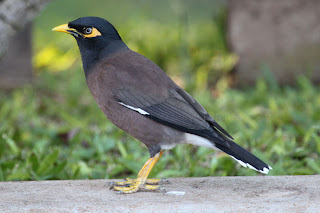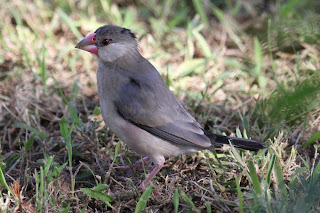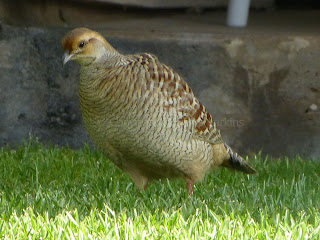Myna
Introduced to Hawaii from India in 1895, the Common Myna was brought in primarily for insect control. Mynas are widespread throughout the Hawaiian islands generally below 5,000 feet. Although technically a member of the starling family, they have similar characteristics to magpies, and enjoy collecting shiny paper or foil. They prefer to skip or walk rather than hop like cardinals and finches. These birds have done so well that the IUCN made the Myna one out of three birds that made it onto the 100 worst invasive species.
Red Crested Cardinal
Another introduced alien species to Hawaii, the beautiful Red Crested Cardinal was originally from Brazil and can also be found in other south american countries. These birds are often seen in pairs in parks and gardens and will readily visit bird feeders.This particular bird was photographed at Ho’okipa overlook, near Paia on Maui's north coast - Ho’okipa being one of the world's top surfing destinations - but we found it also to be a great spot to see both species of Cardinal - the Northern Cardinal and the Red Crested Cardinal.
Japanese White Eye (Mejiro)
Another introduced species, the Japanese White Eye is normally found in Japan and throughout Asia, where it is known by its Japanese name "Mejiro". At 10cm in length, it is a sociable bird with yellow-green plumage and cream underbelly. A characteristic white ring around the eye makes it unmistakable. The Japanese White Eye feeds on fruit, flower nectar and small insects and can be seen at lower and higher elevations across Maui, including urban areas where it feeds on Hibiscus and other flowering plants.
Java Sparrow
The Java Sparrow (or Java Finch) is quite unlike any other sparrow you may have seen! This gregarious bird was introduced from Indonesia and can often be seen in urban areas and often in large flocks at bird feeders in urban areas.
15cm in length, it is a popular cage bird and is still widely bred in captivity.
The Java Sparrow primarily feeds from grass and seeds and the sexes are dissimilar - the male having an all-grey upper parts and a pink underbelly, whereas the female Java Sparrow is more fawn brown in colour.
Java Sparrows are considered a pest in Asia where they damage rice crops. As a result they have been banned from being kept as a cage bird in parts of the USA, including California.
15cm in length, it is a popular cage bird and is still widely bred in captivity.
The Java Sparrow primarily feeds from grass and seeds and the sexes are dissimilar - the male having an all-grey upper parts and a pink underbelly, whereas the female Java Sparrow is more fawn brown in colour.
Java Sparrows are considered a pest in Asia where they damage rice crops. As a result they have been banned from being kept as a cage bird in parts of the USA, including California.
Northern Cardinal
The Northern Cardinal is a stunning songbird, also known as the Redbird or Common Cardinal. It is also found across the US mainland from Maine to Texas.
At 21cm in length the Northern Cardinal has distinctive bright red plumage and can be seen across Maui, particularly at lower elevations in trees, parks and gardens in urban areas. This male bird was seen at Ho’okipa overlook. Female Northern Cardinals are a buff brown colour with red tints and a red beak.
At 21cm in length the Northern Cardinal has distinctive bright red plumage and can be seen across Maui, particularly at lower elevations in trees, parks and gardens in urban areas. This male bird was seen at Ho’okipa overlook. Female Northern Cardinals are a buff brown colour with red tints and a red beak.
Spotted Dove
Introduced to Hawaii from China, the Spotted Dove is very common in urban areas across Maui and the other Hawaiian Islands and can frequently be seen feeding off grains, seeds and fallen fruit.
At 28cm, the Spotted Dove has characteristic black patch on its neck with attractive white spots - giving the bird its name and a pink underbelly.
At 28cm, the Spotted Dove has characteristic black patch on its neck with attractive white spots - giving the bird its name and a pink underbelly.
Zebra Dove
Introduced in 1922, The Zebra Dove can be seen everywhere across the lowland areas of Maui from car parks, side walks to restaurants where it feeds off food scraps dropped by restaurant patrons. It is without doubt, Maui's most common bird.
Smaller than the Spotted Dove at 23cm, males can frequently be seen doing a courtship display where they bow whilst fanning their tail.
Smaller than the Spotted Dove at 23cm, males can frequently be seen doing a courtship display where they bow whilst fanning their tail.
House Finch
An attractive medium sized finch of about 12.5cm - 15cm in length, the House Finch is predominantly a ground feeding bird which eats grains, seeds and berries. It will also feed at garden Nyjer feeders.
House Finches can be seen in many urban areas across Maui, particularly in parks and gardens. The male House Finch pictured right was photographed at Kalama Beach Park in Kihei.
House Finches can be seen in many urban areas across Maui, particularly in parks and gardens. The male House Finch pictured right was photographed at Kalama Beach Park in Kihei.
Gray Francolin
Native to the Middle East and the Indian subcontinent, Gray Francolins are another introduced bird to Hawaii. They can be found in the dry lowland regions of Maui on the leeward side of Haleakala foraging in scrub-land for grains and small insects including termites.
The Gray Fracolin is also known as a Gray Partridge and the loud call of male birds is commonly heard early in the morning where they can be seen perching on the roof tops of buildings.
The Gray Fracolin is also known as a Gray Partridge and the loud call of male birds is commonly heard early in the morning where they can be seen perching on the roof tops of buildings.


.jpg)











